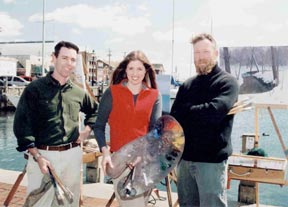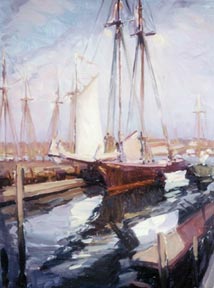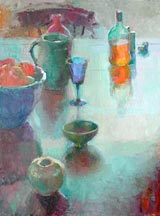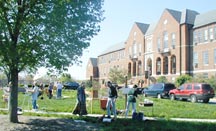
|
Art Comes Out in the Open
Born in Chicago in 1901, Hensche was a giant in the American impressionist movement. Hensche was 82 when the 20-something Ebersberger went to study with him at his Cape School in Provincetown, Mass. The young painter went back every summer until Hensche’s death in 1992. At Cape School he learned about color, light and form from the master who traced his own ideas about painting to the roots of French impressionism. “I consider myself very lucky to have studied with a painter who was in a direct lineage from Monet,” says Ebersberger. “It’s like I studied with this wise wizard and he gave me this magic. That knowledge is so rare and valuable, and now I’ve passed along these same assumptions to my students.”
Painting out of doors wasn’t practical until the invention of the collapsible paint tube in the mid 1800s, according to Millersville plein air artist Jean Brinton Jaecks. Before that, painters might leave their studios to make a quick scene sketch outdoors, but they came back inside to do the actual painting. That’s because before tubes, paints were homemade and stored color by color in pigs’ bladders. The more portable technology made working outdoors easier — and, presumably, more attractive — than lugging around cartons of paint-oozing innards. It also had a profound effect on the development of a new kind of art: French impressionism. In the 1870s, Monet and his compatriots — Edouard Manet, Edouard Degas and Auguste Renoir — introduced painting to a new way of seeing. They saw that forms in the natural environment were affected by sunlight and shadow. In response, they developed a new system using complementary colors to translate that experience. Since light is restless and shifty — constantly changing throughout the day — and is affected by weather, the impressionist’s method is to capture a slice of time on canvas. French impressionism jumped the Atlantic in the late 19th century via New York artist William Merritt Chase. A tonalist (a way of representing light using the gray scale tinted with color), Chase traveled often to Europe where he was, well, impressed by what the impressionists were creating with their bright palettes and nouveau ideas. Chase’s switch to this style led to the rise of an American brand of impressionism that became the era’s predominant art form. Later, a Chase student named Charles Webster Hawthorne opened the Cape Cod School of Art in Provincetown, where he taught Chase’s techniques and plein air style. By the early 1900s, the school was one of the top places to study art in the United States. It became famous for Hawthorne’s style, which combined elements of impressionism, tonalisim and realism. (When Hawthorne died in 1930, the school closed. Hensche reopened it in 1935, altering the name slightly by deleting the word Cod.) Hensche was a Cape Cod School star. Just as he fiddled with the name of Hawthorne’s school, he preferred Monet’s approach to figures, light and color. His obsession — creating form by adjoining large color masses — permeated his teaching. Through the Maryland plein air scene, it moves like a virus — albeit one that Bay artists don’t seem to mind catching or spreading.
Among first-generation Hensche students in and around Annapolis, two of the most influential are the outdoor portrait painters Cedric and Joanette Egeli, who live and work near Galesville. The Egelis are part of a painting dynasty sprung from Cedric’s late father, Bjorn, that now includes three of their children. Describing the qualities that separate the wheat from the chaff among artists, Cedric explains that “you have to know about color, you have to know about shape, that’s the language you use. If you don’t have the language, you can’t express anything,” he says. Cedric learned much of his language from Hensche. “Henry taught that all painting was about color blocks, what he called ‘the essentials of visual logic,’” Cedric says. “He taught his students to see everything in terms of these color blocks.” What they’ve learned from other artists and nature firsthand has evolved into a more global approach to plein air than Hensche may have approved of. Cedric’s Norwegian-born father also influenced both Egelis. Joanette says her father-in-law is the one who actually taught her how to draw. (She claims Hensche was a sexist who didn’t like having women in his classes. But she and Cedric sent their students to study with Hensche because “He was the only teacher on the East Coast that knew anything about light and color.”) Now that they’re the teachers, the Egelis ask students to “see the event.” “We’re teaching our students more to understand what they’re looking at and to fine-tune their senses. And to make that automatic. It’s a little backwards from Henry,” Cedric says. “We say ‘look at the whole scene. Why does it change? Why is it brighter in the shade?’ This way we can be more creative rather than just being a slave to what’s in front of us." From the Inside Out The virus mutated in another way in Hensche student Jean Jaecks, who teaches at St. John’s College and Anne Arundel Community College and also holds private workshops. Jaecks calls her approach alla prima, directly from life. She was inspired by Hensche’s color and light fundamentals, but she also strives to impart something more of herself in her work and encourages her students to do the same. “I’m an individual with my own emotions. I want these to show in my work. And I want the spirit of my students to also come through.” Jaecks’ students, in turn, praise her for helping them discover the artist in themselves as well as teaching technique. Primarily a watercolorist (many more plein air artists use oil), Jaecks paints landscapes, still lifes and interiors. Subject matter for her landscapes is mostly local gardens, including her own. Each painting, she says, is her personal response to the environment. “Artists have a heightened awareness of what is happening in nature,” she says. The hard part is making the paint reflect what it’s like to be in the day. “Feel the warmth of the sun on your back,” she challenges. “How do you express that?”
Local Young Impressionists
There’s talent aplenty in Chesapeake Country, but talent is not enough for an art community to thrive. Galleries like McBride’s help introduce and support artists and styles. McBride’s living-room comfortable gallery is one of several that represents locals. Cynthia McBride — who is the daughter of one accomplished artist and parent of another — says her role is to help promote artists and educate buyers. “A major show usually pushes an artists to the next level in their work because they devote such a concentrated painting effort,” McBride says. “When I plan shows, I am very conscious that the event will be forever recorded in art history.” For buyers, on the other hand, “a show is a gallery’s vote of confidence for an artist, so it means that collectors have a guarantee of quality.” Plein air artists — whose subjects and styles are usually drawn from real life rather than the abstract — are especially suited to the conservative Annapolis environment, McBride says. “We are on the onward and upward side of excitement and interest in plein air painting,” she says. “I wanted to showcase this new generation of young talent, revealing the lineage and history of their mentors that led them to this point.” See The Young Impressionists thru June 22: 10am-7pm Th; 10am-5:30pm MTuWFSa; noon-5:30pm Su @ McBride Gallery, 215 Main St., Annapolis. free: 410/267-7077 • www.mcbridegallery.com.
|
© COPYRIGHT 2003 by New Bay Enterprises, Inc. All rights reserved.
Last updated June 19, 2003 @ 3:22am





